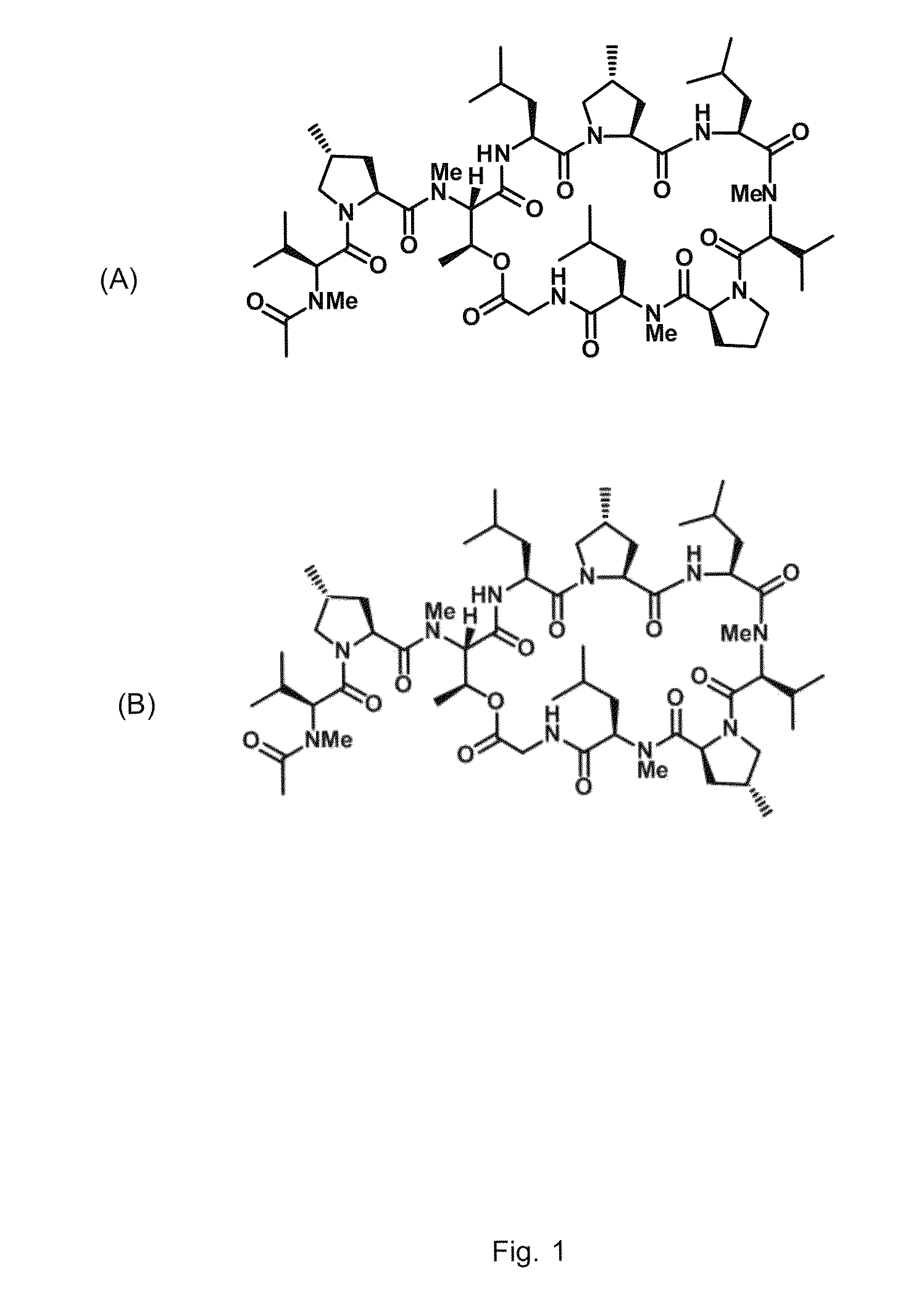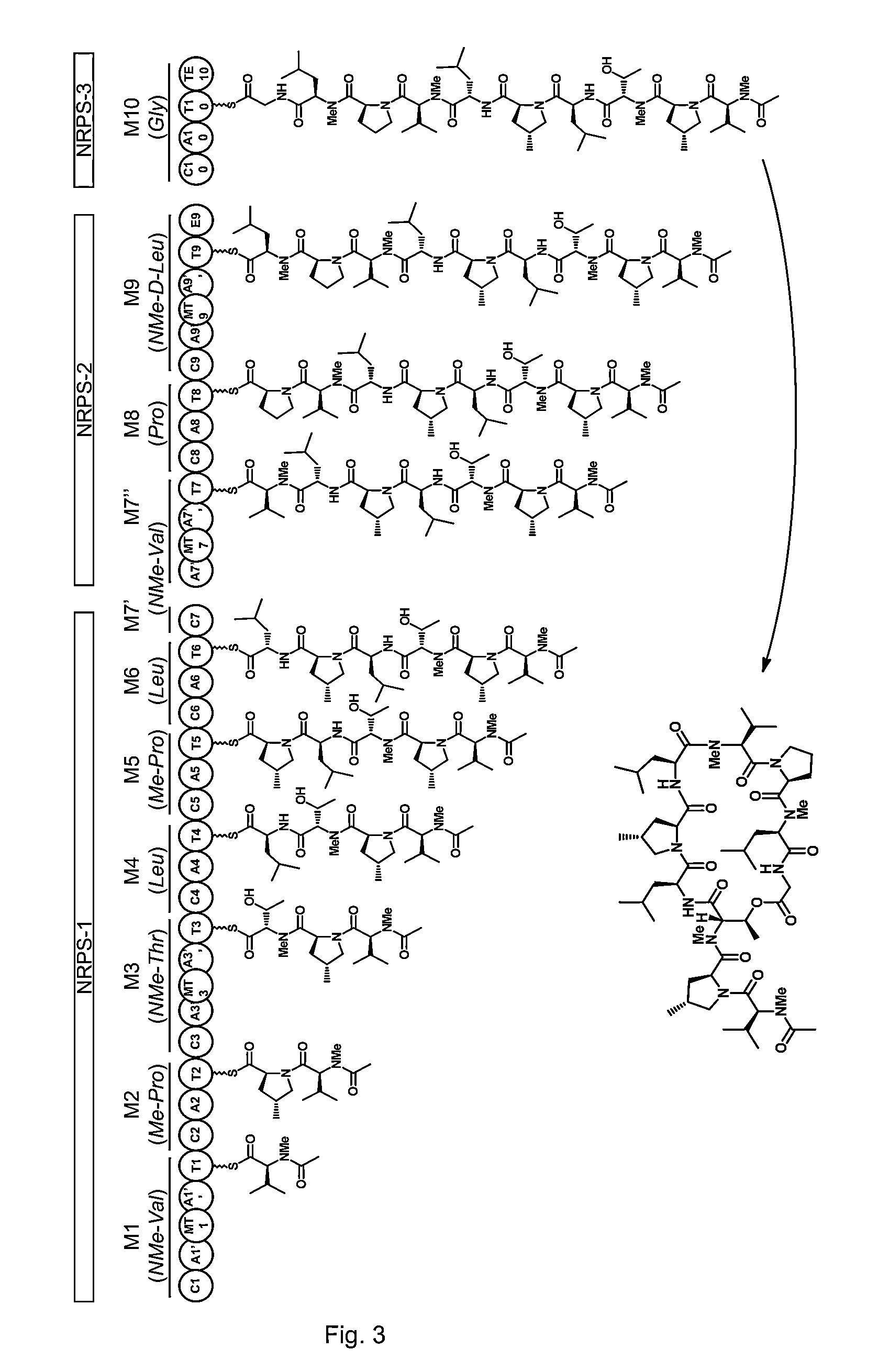Gene cluster for biosynthesis of griselimycin and methylgriselimycin
a technology of methylgriselimycin and gene cluster, which is applied in the field of gene cluster for biosynthesis of griselimycin and methylgriselimycin, can solve the problems of limited targeting and modification and the lack of identification of the gene locus responsible for griselimycin biosynthesis so far
- Summary
- Abstract
- Description
- Claims
- Application Information
AI Technical Summary
Benefits of technology
Problems solved by technology
Method used
Image
Examples
example 1
Identification of the Griselimycin Biosynthesis Locus in Streptomyces DSM 22643
[0133]Streptomyces DSM 22643 naturally produces the antibiotics griselimycin and methylgriselimycin. However, the genetic locus involved in the biosynthesis of these antibiotic substances was not previously identified. For the identification of the griselimycin locus, Streptomyces DSM 22643 was cultured according to standard microbiological techniques. DNA was extracted according to standard procedures and the total sequence was determined according to standard procedures. Analysis of the genes comprised by the DNA of Streptomyces DSM 22643 and proteins encoded by the genes was performed in silico. Table 1 lists the genes identified by ORF numbers which were determined by homology searches. Specific gene designations were assigned to the ORF numbers. The location of the genes and their arrangement within the griselimycin biosynthesis gene cluster is schematically indicated in FIG. 2.
[0134]
TABLE 1ORFgenege...
example 2
Genes and Proteins Involved in the Biosynthesis of Griselimyin and Methylgriselimycin
[0135]By in silico analysis it was determined that the griselimycin biosynthesis gene cluster comprises 26 genes encoding 26 proteins. The biological function of the 26 (methyl)griselimycin biosynthetic proteins was assessed by computer comparison of each identified protein with proteins found at the NCBI. Table 2 identifies the proteins as comprised by the griselimycin biosynthesis gene cluster and the corresponding GenBank proteins found by the homology searches.
[0136]
TABLE 2best blast hitidentity / ORFGenBank AccessionnearestsimilarityputativenumberBest blast hitnumberhomologue ine-Value(%)function1TlmR2ABL74963.1Streptoalloteichus hindustanus2E−5535 / 53Xre family transcriptionalregulator2Hypothetical proteinZP_07294072Streptomyces hygroscopicus5E−1141 / 47Hypothetical proteinSSOG_02153ATCC 536533Conserved hypotheticalZP_06583961Streptomyces roseosporus3E−1561 / 86ConservedproteinNRRL 15998hypothetical ...
example 3
In Vitro-Synthesis of L-trans-4-methylprolin
[0143]In vitro-synthesis of L-trans-4-methylproline can be performed by coupling three subsequent assays, namely the Mps-1 assay, the Mps-2 assay and the Mps-3 assay. Cyclisation of γ-methylglutamic acid γ-semialdehyde to 3-methyl-Δ1-pyrroline-5-carboxylic occurs spontaneously or may involve Mps-3. FIG. 4 shows the conversion of L-leucine to (2S,4R)-4-methylproline using Mps-1, Mps-2, possibly Mps-3 and Mps-4.
[0144]Based on in silico analysis it was found that the mps-1 gene encodes a leucine hydroxylase. The following experimental procedure was performed which confirms that the Mps-1 protein encodes a leucine hydroxylase.
[0145]The putative leucine hydroxylase encoding gene mps-1 was amplified using the primers Gri3_for (5′-GCCGCCATATGATGCAGCTCACGGCCGAT-3′) (SEQ ID NO: 28) and Gri3_rev (5′-GGTCAGGATCCTCATGCCAGCCTCGATTC-3′) (SEQ ID NO: 29) from genomic DNA from Streptomyces DSM 26643 with Phusion polymerase and ...
PUM
| Property | Measurement | Unit |
|---|---|---|
| temperature | aaaaa | aaaaa |
| temperature | aaaaa | aaaaa |
| temperature | aaaaa | aaaaa |
Abstract
Description
Claims
Application Information
 Login to View More
Login to View More - R&D
- Intellectual Property
- Life Sciences
- Materials
- Tech Scout
- Unparalleled Data Quality
- Higher Quality Content
- 60% Fewer Hallucinations
Browse by: Latest US Patents, China's latest patents, Technical Efficacy Thesaurus, Application Domain, Technology Topic, Popular Technical Reports.
© 2025 PatSnap. All rights reserved.Legal|Privacy policy|Modern Slavery Act Transparency Statement|Sitemap|About US| Contact US: help@patsnap.com



